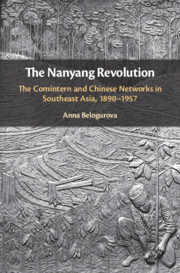Book contents
- The Nanyang Revolution
- The Nanyang Revolution
- Copyright page
- Contents
- Figures and Tables
- Acknowledgments
- Note on Transliteration
- Terms and Abbreviations
- Part I Revolution in the Nanyang
- Part II The Comintern, the MCP, and Chinese Networks, 1930–1935
- 4 The MCP as a Hybrid Communist Party
- 5 The Comintern, Malaya, and Chinese Networks, 1930–1936
- Part III The GMD, the MCP, and the Nation: Minzu Cultivated, Minzu Lost
- Selected Bibliography
- Index
5 - The Comintern, Malaya, and Chinese Networks, 1930–1936
from Part II - The Comintern, the MCP, and Chinese Networks, 1930–1935
Published online by Cambridge University Press: 23 August 2019
- The Nanyang Revolution
- The Nanyang Revolution
- Copyright page
- Contents
- Figures and Tables
- Acknowledgments
- Note on Transliteration
- Terms and Abbreviations
- Part I Revolution in the Nanyang
- Part II The Comintern, the MCP, and Chinese Networks, 1930–1935
- 4 The MCP as a Hybrid Communist Party
- 5 The Comintern, Malaya, and Chinese Networks, 1930–1936
- Part III The GMD, the MCP, and the Nation: Minzu Cultivated, Minzu Lost
- Selected Bibliography
- Index
Summary
An unintended result of the MCP’s interaction with the Comintern was the strengthening of Chinese networks globally through the institution of the party and of the League Against Imperialism. The Comintern pushed the MCP to establish connections with other communists in Southeast Asia while fomenting a world revolution and requested that the MCP involve locally born Chinese along with non-Chinese in its movement. Comintern Chinese networks also ran through the CPUSA and its empire in the Philippines in addition to the Comintern network focused on Southeast Asia. Comintern interactions with the MCP represented a case of synthesis. The organizational culture of the Bolshevik Party offered a democratic participation model alternative to that of the British state. It was based on a culture of self-criticism and therefore allowed room for local communists to criticize the Comintern. The Comintern’s mutually reliant regional relationship with the MCP as a CCP chapter helped the MCP carve out its niche as liberators from British colonialism and provided for the livelihood of Southeast Asian Chinese communist enclaves through the network, connected by corridors of money, culture, and communication.
Keywords
- Type
- Chapter
- Information
- The Nanyang RevolutionThe Comintern and Chinese Networks in Southeast Asia, 1890–1957, pp. 115 - 154Publisher: Cambridge University PressPrint publication year: 2019

